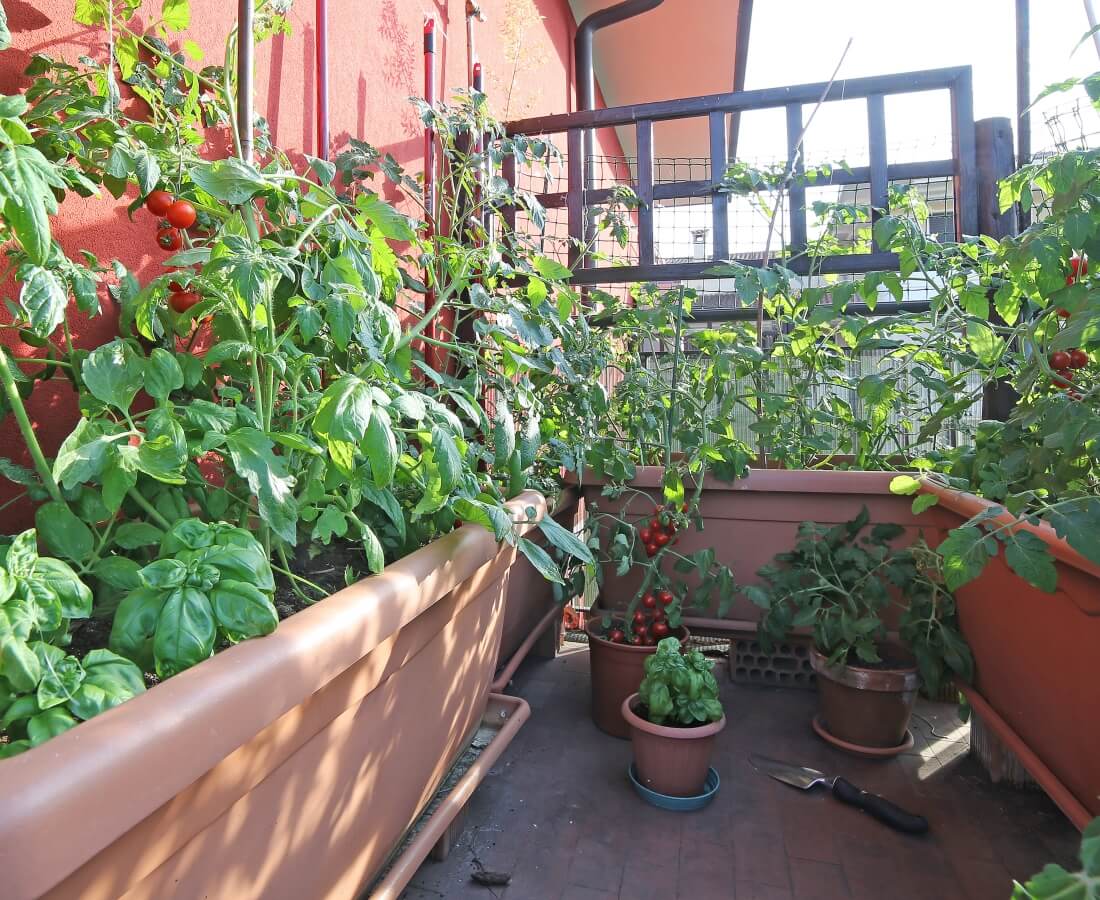However, finding a place to build your garden in this concrete jungle called cities can be a little challenging. There are concrete buildings, roads, markets everywhere you see. Does that mean all the plant lovers living in the cities can’t build their gardens anymore? Well, what are rooftops for? Just think of your roof garden with all the beautiful flowers, fresh organic veggies, and fruits just a few steps away from you. One can easily transform their rooftop into a terrace garden.
It doesn’t matter how big or small your rooftop is, with the right planning and little efforts you can transform your terrace into a garden. It’s a myth that building a terrace garden costs a lot. There are multiple ways to go about revamping your terrace, it all depends on the time and money investment you are willing to make.
In this extensive guide, we’re going to tell you everything you need to know about building your terrace garden from scratch.
Benefits of Terrace Garden

Before getting into the details of how to go about building a rooftop garden, let’s look at a few reasons that will inspire you to get growing your roof garden:
Supply Of Nutritious Greens
What’s better than the fresh supply of home-grown veggies and fruits every day from your garden. Organic vegetables and fruits are more nutritious than the ones we buy from food markets and are great for your health.
Imagine the hot soup that you prepare using the fresh vegetables from your garden. Mouthwatering and full of nutrition.
The food that we source from markets and grocery stores are usually grown with the help of chemical fertilizers. This chemical then seeps into your food system and can eventually lead to health hazards. Growing your own food will help you ensure the good quality of food that you consume on the daily basis.
Ace Your Space
Building a terrace garden helps in keeping your home cool, it is great for the people living in tropical areas. All the plants growing on your terrace will create a micro-environment and will lower the temperature of the place. So while you enjoy the wholesome home-grown food you also save up on big bills from ACs.
Reduces Your Carbon Footprint
By building a garden at your home you will help the environment and reduce your carbon footprint. The plants that you grow will improve air quality. Farming done using chemical materials deteriorates the soil quality and pollutes air and water.
Stay Connected With Nature
Having your terrace garden gives you access to nature 24*7. As they say, “Nature is man’s best friend”. It keeps you disconnected from all the stress and chaos of the world. Having your own terrace garden means having access to your peaceful corner at all times.
Helps You Stay Fit
Gardening is always a great exercise, the number of efforts you will put into maintaining your garden will help you stay fit and active. Taking care of your plants, watering them, and other activities will keep you physically active and away from your everyday boring exercising routine.
Basics Of Rooftop Gardening
Once you make up your mind about building your rooftop garden, you’ll have to make a checklist and keep the following things in mind to help you get started.
Prepare A Sketch/Layout Of Your Terrace Garden

Before you start putting your gardening skills to use, make a rough sketch of your rooftop garden. Plan how you are going to proceed with planting your greens. Whether you’ll be planting them in containers, raised beds, or making use of the vertical space on your terrace.
You can also make a sitting arrangement in the center of your garden to get your daily dose of nature. Here’s how to make the most of your space with Containers, Raised Beds, Trellises, and Vertical Planters.
Equipment Or Tools Required For Rooftop Gardening

These gardening tools will come in handy when you start working on your terrace garden. You can stick to this list of gardening tools and save yourself and your wallet from an overwhelming trip to the gardening store. These five tools will help you get off to a strong start.
-
Trowel
-
Hose Pipe Or Watering Can
-
Shovel
-
Gardening Rake
-
Pruning Scissor
Soil Preparation

Healthy soil leads to healthy plants! Soil that is properly nourished and conditioned is the key to growing proper plants. Create your potting mixture by mixing soil with organic compost. The ideal soil for your terrace garden should neither be too compacted nor too light. The soil should have a balanced texture, crumbly soil that can retain the moisture is good for the plants.
Feed your soil with organic compost regularly. The important nutrients can get washed away from your rooftop garden soil with the rains. Therefore, it is necessary to fertilize them for a good yield. Avoid using chemical fertilizers as it will not only seep into your system but it will also harm the good bacterias and microbes in your soil.
Prepare your potting mix by taking equal portions of red sand, organic compost, and coco peat. Mix it well and leave your potting mix to settle a week or two before using it in containers. Ensure that the texture of your potting mixture is balanced. To keep your soil healthy, you can keep fertilizing it every now and then. This in turn will keep your greens healthy. Here’s how to prepare organic fertilizers at home.
Waterproofing

If you are planning to build soil patches and raised beds on your terrace then it’s important to start with waterproofing. It will help you to prevent any potential damage to the building. Waterproofing can be easily done and the great thing is that it’s only a one-time job.
Waterproofing is an important step in the process of building a terrace garden. It’s like laying the foundation of the building before you start constructing. Leakages and roof damage can get difficult to manage for the people living in and around the building.
Waterproofing can be done in various ways, one of the effective ways to waterproof your roof is by the application of polymer coating on the concrete slab. Once the coating is done, you can get started with your terrace garden.
Read more about how to waterproof your terrace for building a garden.
Wind Barriers

If you are located in a place where your plants are exposed to strong winds, then installing some wind barriers can help protect them. Wind barriers can reduce the pressure of the wind and provide shelter for your plants.
Start by figuring out the direction of the wind and build your wind barriers accordingly. Trellises, hedges, fences, or shelterbelts can be effective windbreakers.
Ensure that the wind barrier you install reduces the wind pressure but should allow proper air circulation for your plants. Installing wind barriers doesn’t have to be a costly affair, you can build one on your own by using a helping hand. Trellis prove to be the best wind barriers.
Sun/Shade

Analyze the hours of the sunlight your balcony receives and the areas that get the maximum amount of sunlight. Pick your plants and place them in the spots that receive ample sunlight.
If your balcony is shady, you can pick out the plants that can thrive in lesser sunlight. Notice the hours of indirect sunlight coming to your balcony and pick your plants accordingly.
All salad greens like arugula, lettuce, spinach, mustard, chard, kale, mizuna, komatsuna can do well in partial shade but all these plants need some amount of sunlight every day to thrive.
Terrace Vegetable Gardening - Veggies To Grow In Your Rooftop Garden

You can grow anything and everything in your rooftop garden. From veggies, herbs, shrubs, microgreens to flowers - you name it. If you are a beginner, then you can start with growing veggies like spinach, coriander, radish, etc. These vegetables can be grown in any season and with minimal efforts.
Things like hours of sunlight, watering, soil PH level, and temperature requirements are a few important factors that you need to consider before picking your seeds to sow on your rooftop garden.
Place your plants at a spot where they will receive ample sunlight and are safe from all the predators.
Start growing your own seasonal vegetables on your rooftop with the help of this vegetable growing season calendar in India. You can also start your gardening expedition by choosing the perfect greens for every season from our wide range of Seed Kits Collection.
Care & Maintenance
Watering

Watering your rooftop garden plants is pretty similar to watering plants in your regular garden. The only difference is that you need a proper drainage system on your rooftop garden for the excess water to flow out. You can water your plants with the help of a watering can or a hose.
Watering your plants in the morning is a great way to keep them hydrated and support the photosynthesis process. The soil in rooftop gardens is shallow and gets dried up quickly. Therefore, watering your plants every day will keep your plants hydrated and healthy.
Bugs & Pests

No matter how good care you take care of your plants, pests will find their way back to feast on your plants. You can use natural pesticides to keep your plants safe and all the bugs at bay. It is very simple to prepare natural pesticides by preparing a mixture of soap water, neem oil, and baking soda.
Spray this magical mixture often on your plants and watch them grow without unwanted bugs flying around them.
Birds & UV Rays

Bugs are not the only ones that can harm your plants. Even birds and harmful sun rays can harm your plants. Keep your plants safe by covering them with a wire mesh or a green net.
Mulching

Mulching your plants is a great way to keep them healthy and hydrated. The mulch will help you keep all the pests away from your plants and retain the moisture for longer periods. You can use hay, shredded wood, or fruit peels as mulch.
Heat Proofing Terrace Garden

Sometimes even sun-loving plants can’t bear excessive heat and need a little extra care during the hottest months of the year, especially in the northern parts of India. Taking measures like watering your plants regularly, providing shade using nets, sufficient nutrient supply can help your plants in surviving the harsh summer heat.
Here are a few tips that will help you to heat-proof your vegetable rooftop gardens.
Pro-Tips For Building Terrace Gardens

These tips will prove to be useful when you think of building your terrace gardens and manage all the downfalls that you might face.
Cost-effective Terrace Gardening
Building a terrace garden from scratch can be a little heavy on your wallet but if you apply these smart tips your wallet will thank you:
- Reuse and repurpose old furniture of your house and turn them into containers for your plants. Old cartons, cardboard boxes, paint boxes, food containers, tables, anything can turn into a container. You don’t have to buy separate containers for growing your plants. Instead, you can decorate the free stuff lying around in your house and use them. This will not only save you money but will also cut down on your waste generation.
- If you’re planning to go big with your terrace gardening then buy seeds in bulk to reduce the cost. Bulk buying is always a smarter way to cut the cost. If you’re looking out to purchase seeds in bulk for your terrace garden, visit AllThatGrows and get access to GMO-free heirloom vegetable seeds.
- Use organic remains like banana peels, coffee grounds, fruit peels, or tea compost to give your plants the nutritional boost instead of using chemical fertilizers. This will not only save the bucks but will also make your food chemical-free.
Prevent Damage To The Building
As we stated before, you need to prepare your rooftop before you start to plant anything to prevent any potential damage. Preparing your rooftop can be a costly affair, you might also need help from an expert.
The roots of the plants can harm the structure of the building. Therefore, preparing the roof before planting any greens is a crucial part.
Here’s a guide that will help you with all the information you need to prepare your rooftop for terrace gardening.
Drainage System
Having a proper drainage system before building a terrace garden is important. Without a drainage system, the excess water will collect in places and damage your roof. Most of the rooftops have water drainage systems installed while it’s built.
Get The Terrace Garden To Yield More Crop
To get the most out of your rooftop garden, start small. Grow plants that fit into small places like herbs, vegetables like chilies, or microgreens. This way you’ll be able to grow a variety of vegetables in a little space.
Grow low-maintenance plants that require little efforts like cherry tomatoes, spinach, chilies, or fenugreek to enjoy good yield. Planting short-season crops will also help you make the most of your space and get the most out of your plants.
Terrace Gardening Investment
It only takes a one-time investment to build a terrace garden. Then, it’s just about maintaining the garden. You will need to invest in waterproofing, equipment, containers, seeds, etc. Once you’re set to plant, you’ll need no penny. You’ll get a constant supply of greens and an abundance of satisfaction.
FAQ’s

Should the terrace slab be 100% waterproof?
Waterproofing your terrace is important as you’re going to cover your terrace with soil and heavy pots. This may create dampness in the structure of the building. Getting help from a professional is how you can tackle the situation.
If you are planning to do it yourself, use a drainage mat thick tarpaulin sheet as a waterproofing agent. A terrace that is free from leakages will ensure a long-term benefit. Once your terrace is ready, you can even cover it with a beautiful lawn.
How should I prepare the layout of my terrace garden?
Preparing a layout/sketch will help you figure out the type of plants, space utilization, and investment requirements. Use the space efficiently, start by marking the areas that are dedicated to plants - big or small.
Make a note of the areas receiving the maximum/minimum amount of sunlight. Cover the areas with too much sunlight with shelters. You can also make a seating arrangement to enjoy nature!
What type of soil and fertilizer to use in my terrace garden?
You can prepare a potting mixture by adding equal amounts of normal soil, vermicompost, and sand. One important thing to note is that after rains, all the important nutrients may wash away from the soil. Replenish your soil every month to keep your plants healthy.
Now that you’re all set with your guide on how to grow a terrace garden, start building one! You will not only be rewarded with tranquility and fresh air but you will also get a regular supply of organic greens every single day. Get your high-quality heirloom seeds from AllThatGrows today!


 Sign In
Sign In





















Let us know your feedback
* Comments must be approved before being displayed.